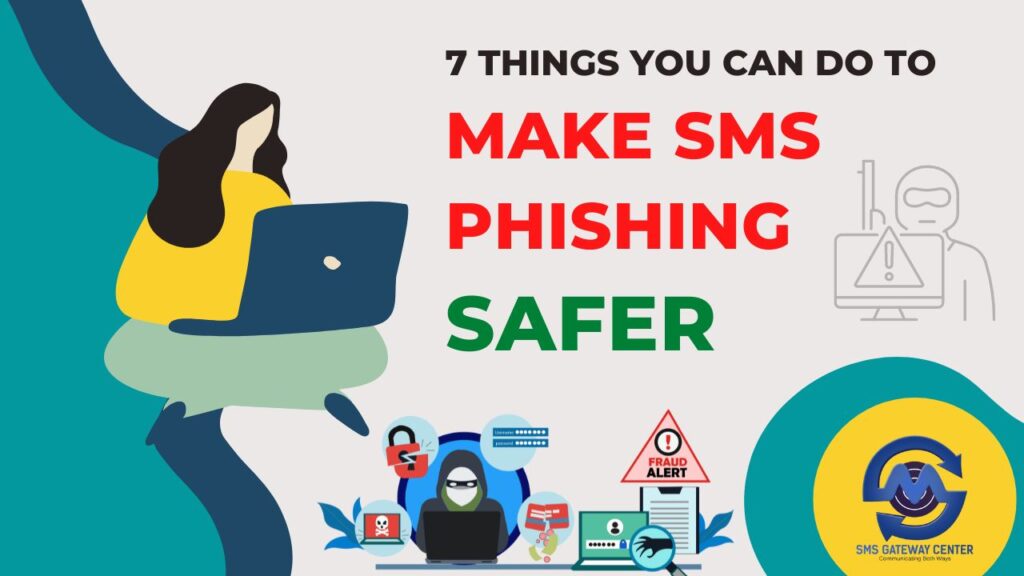7 Things You Can Do to Make SMS Phishing Safer
Phishing is a type of fraud where an email or text message lure you to provide personal information or make online purchases using your account details. There are millions of people fall prey to these phishing schemes every year because it looks like it to come from a trusted company, while they actually come from criminals. Never give away your personal information such as bank account number to someone you do not know and don’t trust. Use of SMS phishing is rising by the day, but there are several ways that you can prevent yourself from falling prey to it. In this article, we will help to expose 7 common SMS phishing scams and what you need to do to prevent falling in one of them.

Do not Click Links in SMS
Despite the fact that SMS phishing, also known as smishing, is not as common as email phishing, it is still a threat. Here are some things you can do to make sure you don’t fall victim to a smishing scam:
- Do not click links in SMS messages, even if they look legitimate. If you’re not sure whether a link is safe, don’t click it. Instead, type the website address into your browser manually to be sure you’re going to the right place.
- Be suspicious of any SMS message that asks you for personal information or login credentials. Legitimate companies will never ask for this type of information via text message.
- If you receive an SMS message that looks like it might be a phishing attempt, report it to your carrier immediately, so they can investigate and take appropriate action.
By following these simple tips, you can help protect yourself from falling victim to a smishing scam.
VPN Services and Fake Wi-Fi Networks
When you’re travelling, it’s important to be aware of the dangers of using public Wi-Fi networks. Many people use these networks without thinking twice, but the truth is that they can be dangerous.
One of the biggest dangers of using public Wi-Fi is that you never know who might be monitoring the network. It’s possible for someone to set up a fake Wi-Fi network in order to try to steal your personal information.
Another danger of public Wi-Fi is that you don’t know what kind of security measures are in place. Some networks are much less secure than others, which means that it’s easier for someone to snoop on your activity or even steal your personal information.
The best way to protect yourself when using public Wi-Fi is to use a VPN service. A VPN (virtual private network) will encrypt your traffic and make it much harder for someone to snoop on your activity or steal your information.
There are many VPN services available, so it’s important to do some research to find one that’s right for you. In general, you’ll want to look for a service that offers strong security features and doesn’t keep logs of your activity.
If you’re concerned about the safety of public Wi-Fi, using a VPN service is the best way to protect yourself. By taking these simple precautions, you can help ensure that you stay safe when using public Wi-Fi networks.
Never Respond to a Phone Call or SMS Asking for Your Personal Information
- Never respond to a phone call or SMS asking for your personal information, even if the caller or sender seems to know who you are. If you get a call from someone claiming to be from your bank, for example, hang up and call the number on the back of your card to confirm that the person is legitimate.
- Be wary of any unsolicited calls or texts, even if they don’t ask for personal information. Scammers often try to gain your trust by pretending to be from a trusted source, like a government agency or well-known company.
- Don’t click on any links in a text message unless you’re absolutely sure they’re safe. Many phishing scams use shortened URLs that can be difficult to tell apart from the real thing. If you’re not sure whether a link is safe, do a quick Google search of the URL before clicking on it.
- Never give out personal information like your Social Security number, date of birth, or bank account information over the phone or in a text message. Legitimate organizations will never ask for this sensitive information via text or telephone call.
- If you think you may have already fallen for a phishing scam, contact your bank or credit card company immediately to report the fraud and cancel any affected accounts. You should also report the scam to the Federal Trade Commission, so they can investigate and take action against the scammers.
Do not Give any Sensitive Information via SMS or Email
- Do not give any sensitive information via SMS or email – This includes things like your social security number, date of birth, banking information, or anything else that could be used to gain access to your accounts or steal your identity. If you receive an email or text message asking for this type of information, do not reply and instead report it to the website or service where you received it.
- Be cautious of links in text messages – Many phishing scams will try to get you to click on a link that takes you to a fake website designed to look like the real thing. If you are unsure about a link, don’t click on it. You can also hover over the link to see where it will take you before clicking (this may not work on all devices).
- Don’t open attachments from unknown senders – These attachments could contain malware that will infect your device or allow the sender to gain access to your personal information. If you’re not expecting an attachment from someone, don’t open it.
- Keep your software and apps up to date – One way scammers can gain access to your personal information is by taking advantage of vulnerabilities in outdated software. By keeping your software and apps up to date, you can help protect yourself from these types of attacks.
- Use anti-virus and anti-malware protection – These tools can help detect and remove malicious software from your device before it has a chance to do any damage.
- Be cautious of public Wi-Fi networks – When using a public Wi-Fi network, be aware that others may be able to intercept the information you’re sending and receiving. Avoid logging into sensitive accounts or entering personal information while using public Wi-Fi.
- Keep your privacy settings updated – Social media and other websites often have settings that control how much of your personal information is shared. By keeping these settings up to date, you can help protect your information from being accessed by people you don’t know.
- Use strong and unique passwords – One way scammers can gain access to your accounts is by guessing your password. Using strong and unique passwords for each of your online accounts can help prevent this from happening.
- Watch out for warning signs – There are some things that can indicate a scam, such as unexpected requests for personal information, threats or ultimatums, unsolicited offers, or grammatical errors in messages. If you see any of these red flags, it’s best to not engage with the person or website and instead report it to the proper authorities.
Stay Alert for Unusual Texts With Grammatical Error
SMS phishing, also known as smishing, is a type of phishing attack that occurs over text message. Smishing scams are on the rise, so it’s important to be aware of how they work and what you can do to protect yourself.
One way to spot a smishing attempt is by looking for unusual texts with grammatical errors. This is often a sign that the text has been sent from a spoofed number or email address. If you receive a suspicious text, do not respond to it and delete it immediately.
You can also protect yourself from smishing scams by never clicking on links or attachments in texts from unknown senders. If you’re unsure about whether a text is legitimate, contact the company directly via phone or their website to confirm before taking any further action.
By following these simple tips, you can help keep yourself safe from smishing attacks.
Never Share Your Password
- Never share your password with anyone, no matter how trustworthy they may seem.
- Create a strong password that is difficult to guess, and never use the same password at more than one site.
- Be suspicious of any email or text message that asks you to enter your password, even if it looks like it’s from a trusted sender.
- Never click on links in messages that ask you to enter your password or personal information. If you’re unsure whether a link is safe, go to the website directly by typing in the URL yourself.
- Be cautious of any attachment in an email or text message, even if it appears to be from a trusted sender. These attachments can contain malware that can harm your device or steal your information.
- Keep your software and apps up to date, as developers often release updates that patch security vulnerabilities.
Read the Entire Text Message Thoroughly
When you receive an SMS message, it’s important to read the entire message carefully before taking any action. This will help you to identify any potential scams or phishing attempts.
If a message looks suspicious, do not click on any links or provide any personal information. Instead, contact the sender directly to confirm that the message is legitimate.
By taking these simple precautions, you can help to keep yourself safe from SMS phishing attempts.
Conclusion
There’s no doubt that SMS phishing is a real and present danger. But there are things you can do to protect yourself and your data. By being aware of the dangers, keeping your software up to date, and being careful about the links you click on, you can make SMS phishing much less of a threat. The above tips will help you protect yourself from being a victim of SMS phishing fraud in the future. Avoid falling into an SMS phishing scam by following these 7 easy steps! Nobody wants to be victim of SMS phishing scams, so by following these tips you can protect yourself and your business against them.

